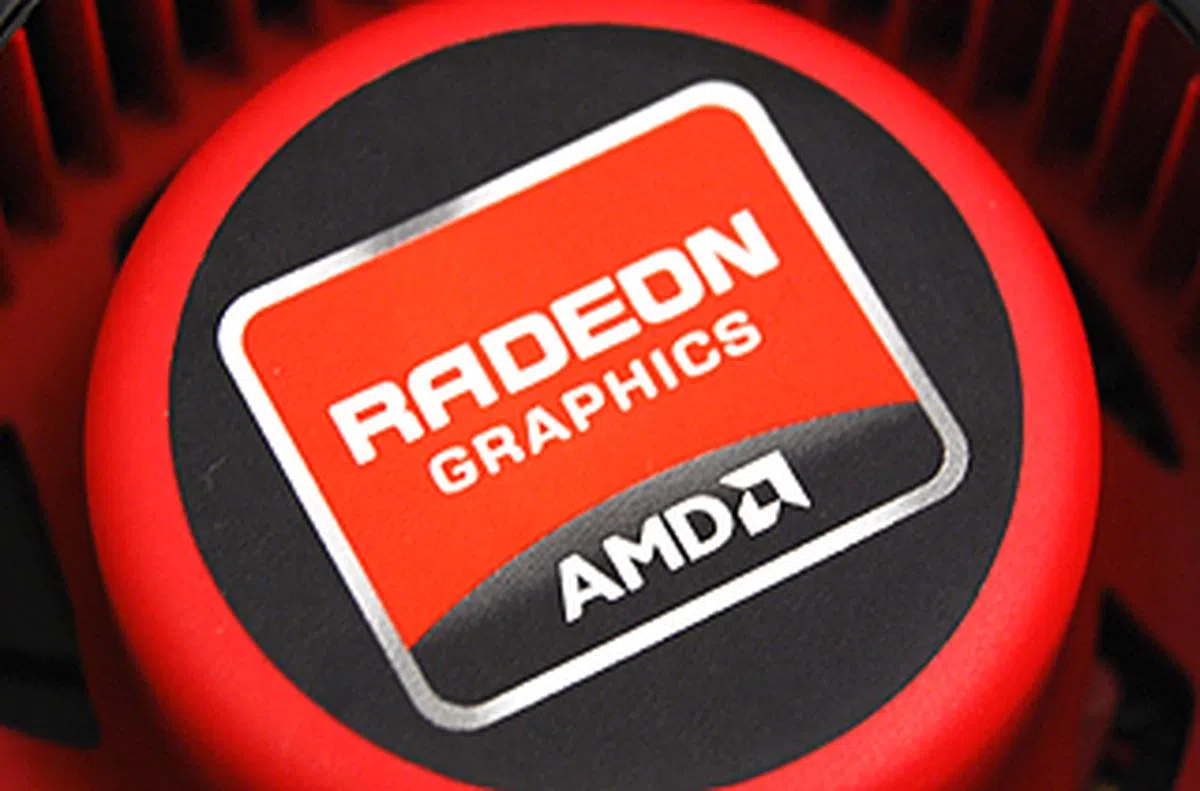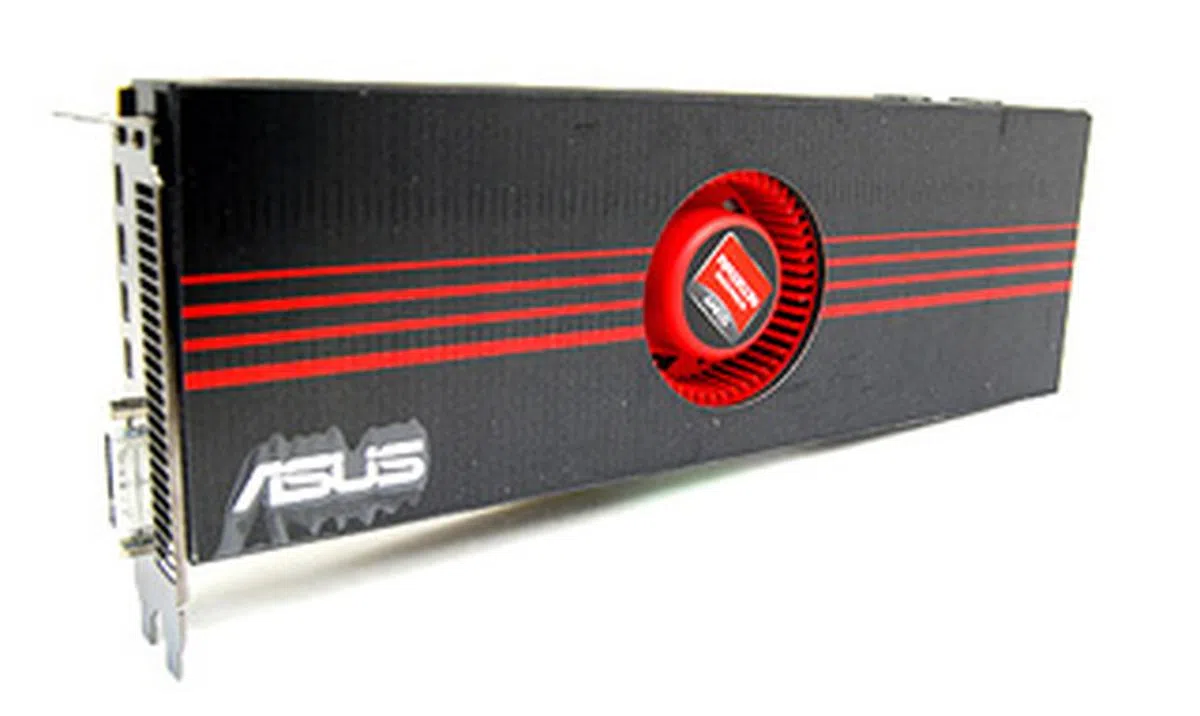AMD Radeon HD 6990 - The New King of Graphics
Boasting dual-GPUs on a PCB with a grand total of 3072 streaming processors and a whopping 4GB framebuffer, the AMD Radeon HD 6990 is the company's latest flagship and also the world's fastest single graphics card. We take it for a spin to see just how powerful it is.
By Kenny Yeo -
The Dual-GPU Monster
Since the Radeon HD 3000 series, AMD’s (previously ATI) flagship cards have been dual-GPU monsters. This trend began in early 2008 with the Radeon HD 3870 X2 and was succeeded by the and then the . And with the introduction of their newest , graphics enthusiasts and power-hungry gamers are eagerly waiting AMD’s next dual-GPU creation.
And it is finally here. The new AMD flagship is the Radeon HD 6990, and it is easily the most powerful card AMD has ever built. Additionally, AMD also claims that it is the most powerful single graphics card in the world. Unfortunately, the AMD Radeon HD 6990 is off to a bad start because first and foremost, like the old Radeon HD 5970, which is really powered by two “detuned” Cypress XT (Radeon HD 5870) chips; the new Radeon HD 6990 is somewhat the same.
To be specific, while the Radeon HD 6990 has two Cayman XT chips with the full 1536 stream processing units, giving it a grand total of 3072 stream processing units, through the use of the dual BIOS functionality of the Radeon HD 6970 and HD 6950, the Radeon HD 6990 has a default mode and OC mode. In default mode, the card runs at 830MHz at the core and 5000MHz DDR at the memory. These clock speeds are substantially lower than a Radeon HD 6970. Furthermore, in this mode, the BIOS is write-protected and therefore the card cannot be overclocked. Put in OC mode, however, and the Radeon HD 6990 will run at higher clock speeds, 880MHz at the core (similar to the Radeon HD 6970) but retains memory speeds of 5000MHz DDR.

AMD's latest flagship is here to reclaim the title of world's fastest single graphics card from NVIDIA. We've with us an ASUS Radeon HD 6990 for evaluation, which is as good as any other offered by the competition since all of them adhere to the reference design and requirements.
Clock speeds aside, the Radeon HD 6990 is in every other sense, double the card of the Radeon HD 6970. Not only does it have double the number of stream processing units, it also has twice the number of texture mapping units and raster operating units, as well as double the framebuffer - a whopping 4GB.
All things considered and even with the slightly stunted clock speeds, the Radeon HD 6990 is a beast of a card and we can’t wait to put it through our benchmarks to find out how fast it will run. Naturally, we are expecting to see some eye-popping numbers. But before we proceed, here’s a look at how the Radeon HD 6990 measures up against its closest rivals.
Model | AMDRadeon HD6990 | AMDRadeon HD6970 | AMDRadeon HD6950 | ATIRadeon
HD 5970 | NVIDIA
GeForce
GTX580 | NVIDIA
GeForce
GTX570 |
Core Code | Antilles | Cayman XT | Cayman PRO | Hemlock | GF110 | GF110 |
Transistor Count | 5280 million | 2640 million | 2640 million | 4300 million | 3000 million | 3000 million |
Manufacturing
Process | 40nm | 40nm | 40nm | 40nm | 40nm | 40nm |
Core Clock | 830 / 880MHz | 880MHz | 800MHz | 725MHz | 772MHz | 732MHz |
Stream Processors | 3072 Stream Processing units | 1536 Stream processing units | 1408 Stream Processing units | 3200 Stream processing units | 512 Steam Processors | 480 Stream Processors |
Stream Processor Clock | 830 / 880MHz | 880MHz | 800MHz | 725MHz | 1544MHz | 1464MHz |
Texture Mapping
Units (TMU) /
Texture Filtering
(TF) units | 192 | 96 | 88 | 160 | 64 | 60 |
Raster Operator
units (ROP) | 64 | 32 | 32 | 64 | 48 | 40 |
Memory Clock | 5000MHz GDDR5 | 5500MHz GDDR5 | 5000MHz GDDR5 | 4000MHz GDDR5 | 4008MHz GDDR5 | 3800MHz GDDR5 |
DDR Memory Bus | 512-bit
(combined) | 256-bit | 256-bit | 256-bit | 384-bit | 320-bit |
Memory
Bandwidth | 320GB/s | 176.0GB/s | 160.0GB/s | 256GB/s | 192.4GB/s | 152GB/s |
PCI Express
Interface | PCIe ver 2.0 x16 | PCIe ver 2.0 x16 | PCIe ver 2.0 x16 | PCIe ver 2.0 x16 | PCIe ver 2.0 x16 | PCIe ver 2.0 x16 |
Molex Power
Connectors | 2 x 8-pin | 1 x 6-pin, 1 x 8-pin | 2 x 6-pin | 1 x 6-pin, 1 x 8-pin | 1 x 6-pin, 1 x 8-pin | 2 x 6-pin |
Multi GPU
Technology | CrossFireX | CrossFireX | CrossFireX | CrossFireX | SLI | SLI |
DVI Output Support | 1 x Dual-link | 1 x Dual-Link, 1 x Single-Link | 1 x Dual-Link, 1 x Single-Link | 2 x Dual-Link | 2 x Dual-Link | 2 x Dual-Link |
HDMI | None | 1 | 1 | 1 | 1 (mini-HDMI) | 1 (mini-HDMI) |
DisplayPort | 4
(mini DisplayPort 1.2) | 2
(version 1.2) | 2
(version 1.2) | 1 | None | None |
HDCP Output
Support | Yes | Yes | Yes | Yes | Yes | Yes |
Street Price | Launch price: US$700 | ~US$369 | ~US$279 | ~US$500 | ~US$529 | ~US$359 |
A Closer Look at the Radeon HD 6990
As we mentioned earlier, we got hold of an ASUS card to evaluate this new monster graphics card, which should represent what the other partners have as well. The ASUS EAH6990 card is based on AMD’s reference design and it measures 12-inches long and weighs over 1kg. Needless to say then, it’s a giant amongst graphics cards.
The first thing you’d notice about this giant card is its new cooler design, which is markedly different compared to the Radeon HD 6970 and HD 6950. The most notable change is the location of the fan. In place of the traditional rear blow fan design, the Radeon HD 6990 now has a cooler with a centrally-mounted fan in between the two GPUs.
With this new cooler design, AMD has also redesigned the heatsink and have also used employed the use of an exotic kind of thermal paste, which they claim is 8% more effective. In place of the single giant vapor chamber cooler of the Radeon HD 5970, the Radeon HD 6990 has a segmented heatsink design with each GPU having its own vapor chamber cooler. According to AMD these changes in the cooler design will enable cooling duties to be more efficiently distributed between the two GPUs and other crucial components such as VRM and memory.
And as befits an ASUS card, the EAH6990 also comes with the usual ASUS suite of software such as Voltage Tweak, ASUS Smart Doctor and ASUS Gamer OSD. Here’s a look at AMD’s latest flagship card.

The Radeon HD 6990 on top, followed by the Radeon HD 5970 and HD 6970.

The AMD Radeon HD 6990 comes with a single dual-link DVI ports and four mini-DisplayPorts (1.2). To accommodate for multi-monitor setups, AMD has insisted all partners bundle the boards with a variety of DVI and HDMI adapters to make full use of the DP connections.

The Radeon HD 6990 draws its power from two 8-pin PCIe power connectors and AMD recommends a PSU rated for at least 750W. For CrossFireX configurations, AMD recommends a PSU rated for at least 1000W.

Lying beside the CrossFireX connector is the BIOS switch. You have to be in OC mode to be able to overclock the card. However, putting the card into OC mode alone voids warranty, more on this in our conclusion.
Test Setup
We’ll be evaluating the new Radeon HD 6990 with our X58 testbed which has the following specifications:
- Intel Core i7-975 (3.33GHz)
- Gigabyte GA-EX58-UD4P motherboard
- 3 x 1GB DDR3-1333 G.Skill memory in triple channel mode
- Seagate 7200.10 200GB SATA hard drive
- Windows 7 Ultimate
The Radeon HD 6990 will be pitted against the current crop of high-end graphics card. We wanted to see just how much faster it will be compared to the AMD’s previous dual-GPU card, the Radeon HD 5970. We also wanted to know how it’ll match up against two Radeon HD 6970 cards in CrossFireX configuration, but unfortunately, our cards refused to CrossFire properly (quite likely due to difference in video BIOS) as it would crash whenever we tried running any benchmarks. So the results for this configuration were based on an older set of cards and drivers where we managed to run this configuration successfully.
Against NVIDIA, we have included results of their two fastest and most powerful cards, the 512 CUDA cores GeForce GTX 580 and the less powerful GeForce GTX 570, and also that of two GeForce GTX 570 cards in SLI. The GeForce GTX 580 in SLI mode is missing from our comparison due to limited availability of test cards.
The list of card tested and driver versions used:
- AMD Radeon HD 6990 4GB GDDR5 (AMD Catalyst 11.4 Preview)
- AMD Radeon HD 6970 2GB GDDR5 (Catalyst 11.2)
- AMD Radeon HD 6970 2-way CrossFireX (Catalyst 10.11)
- AMD Radeon HD 5970 2GB GDDR5 (Catalyst 11.2)
- NVIDIA GeForce GTX 570 2-way SLI (ForceWare 263.09)
- NVIDIA GeForce GTX 580 1560MB GDDR5 (ForceWare 266.58)
- NVIDIA GeForce GTX 570 1280MB GDDR5 (ForceWare 263.09)
The list of benchmarks used:
- Futuremark 3DMark Vantage
- Futuremark 3DMark 11
- Crysis Warhead
- Far Cry 2
- Warhammer: Dawn of War 2
- Battlefield Bad Company 2
- “Heaven" from Unigine v2.1
- S.T.A.L.K.E.R.: Call of Pripyat
3DMark 11 and 3DMark Vantage Results
We begin first with the latest 3DMark 11 benchmarking utility which makes use of the various DirectX 11 functions such as tessellation and DirectCompute. In OC mode, the Radeon HD 6990 managed about 3% higher scores than it would have had it been in default mode. In OC mode, it was also managed to match two Radeon HD 6970 in CrossFire, although its scores were marginally lower.
It also completely pummeled NVIDIA’s flagship GeForce GTX 580, outscoring it by more than 50%. Of course, 3DMark 11 is still a new benchmark and we've yet to obtain the full set of comparison results like dual GTX 570 and dual GTX 580 for example.

Moving onto Vantage, in default mode, the Radeon HD 6990 scored about 15% better than the old Radeon HD 5970, and about 25% better than the GeForce GTX 580. We also noted that in OC mode, the Radeon HD 6990 in OC mode score marginally better than in default mode. However, it still lost out to two Radeon HD 6970 in CrossFire as well as two GeForce GTX 570 cards in SLI.

Crysis Warhead & Far Cry 2 Results
On to the first of our real world gaming applications, Crysis Warhead, we noted that in default mode, the Radeon HD 6990 continues to trail two Radeon HD 6970 in Crossfire configuration. However, it was able to match two GeForce GTX 570 in SLI, and it outperformed the old Radeon HD 5970 by close to 20% and a single Radeon HD 6970 by more than 60%.


On Far Cry 2, the cards were so powerful that the results show that they have been bottlenecked by the CPU, even with 8x anti-aliasing enabled. And mind you, ours is a pretty high-end Core i7-975. It just goes to show that these cards need to be paired with a sufficiently powerful system to be able to fully maximize and extract every ounce of their performance. That said, the GeForce cards put up a good show as usual and the GTX 570 in SLI was comfortably well ahead of the Radeon HD 6990.


Dawn of War 2 & Battlefield Bad Company 2 Results
It was pretty much the same story with Dawn of War 2, as many of cards achieved very comparable scores in the region of around 77 to 79 frames per second. Being an RTS game, Dawn of War 2 is easily bound by CPU performance, especially if there’s a large number of units on screen at the same time, and this reaffirms the fact that to get the best out of these high-end graphics cards, you need an equally powerful CPU. At the same time, it goes to show that you don't need to be worried of having a super fast GPU to run such RTS games.

The Radeon HD 6990 pulled ahead on the lower 1650 x 1050 resolution, and recorded frame rates that were about 12% higher than two Radeon HD 6970 in CrossFire, and was about 20% faster than both the GeForce GTX 580 and GTX 570 in SLI. On the higher 1920 x 1200 resolution, the two Radeon HD 6970 in CrossFire managed to claw itself back and put itself almost on a par with the Radeon HD 6990. On a whole, the Radeon HD 6990 was about 75% faster than a single Radeon HD 6970.

Unigine "Heaven" 2.1 Results
On Unigine, the Radeon HD 6990 was more than 80% faster than a single Radeon HD 6970. However, it still lost out to two in CrossFire configuration. And again, the Radeon HD 6990 in OC mode was a smidge quicker than in default mode.
Interestingly, looking at the DirectX 11 results, we can just how far AMD has come in improving the tessellation of their cards as a the dual-GPU Radeon HD 5970 was only as fast as a single Radeon HD 6970. But when running on DirectX 10, the Radeon HD 5970 picked up speed and left the HD 6970 trailing in its wake.
The Radeon HD 6990 was also more than a match for the NVIDIA cards, outpacing two GeForce GTX 570 in SLI by around 10%, and a single GeForce GTX 580 by a whopping 50% overall.
DirectX 11 Results


DirectX 10 Results


S.T.A.L.K.E.R.: Call of Pripyat Results
On S.T.A.L.K.E.R.: Call of Pripyat, the Radeon HD 6990 continued to trail two Radeon HD 6970 in CrossFire, even when it was in OC mode. It also trailed two GeForce GTX 570 in SLI, but this was only in DirectX 11 with tessellation enabled. Running on DirectX10 and with tessellation disabled, the Radeon HD 6990 proved to be quicker than two GeForce GTX 570 SLI, showing again that the Radeons have the edge in DirectX 10 applications. The Radeon HD 6990 also posted credible gains over a single Radeon HD 6970 and a single GeForce GTX 580.
DirectX 11 Results
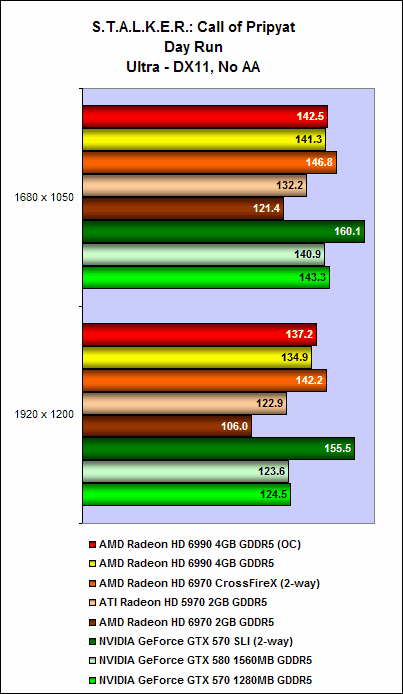 | 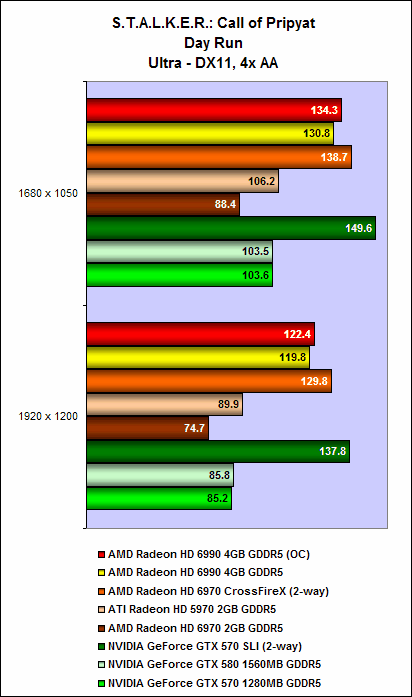 |
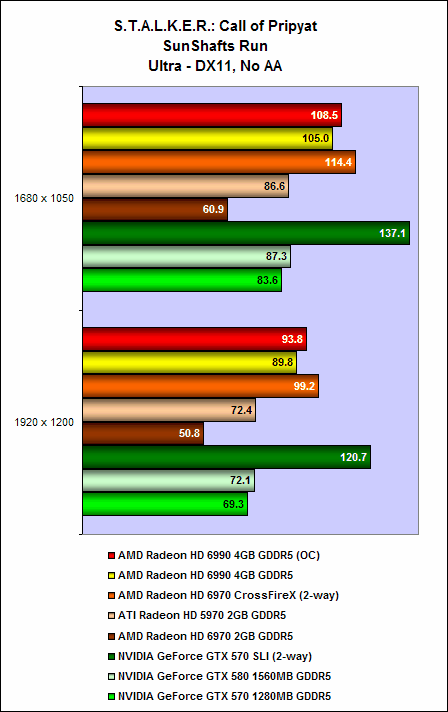 | 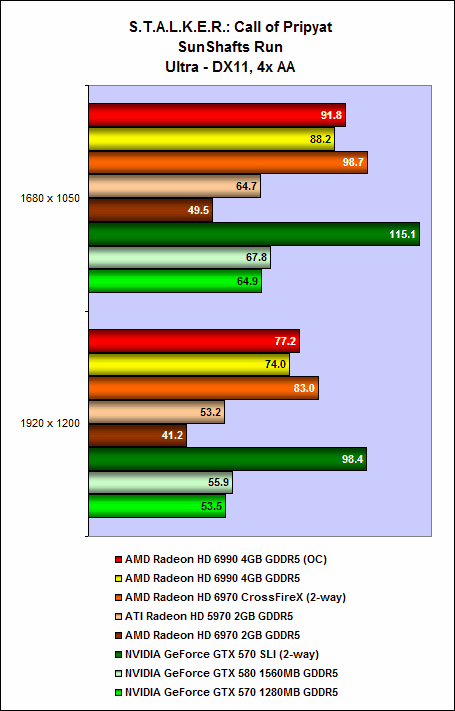 |
DirectX 10 Results
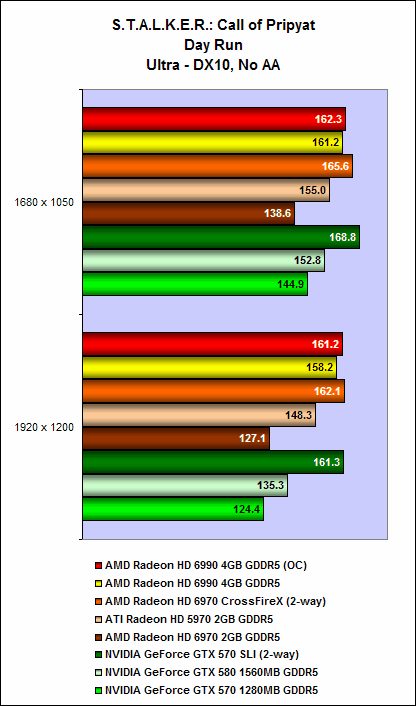 | 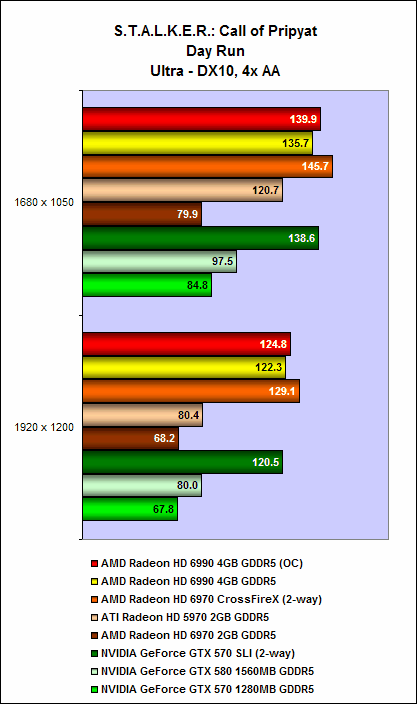 |
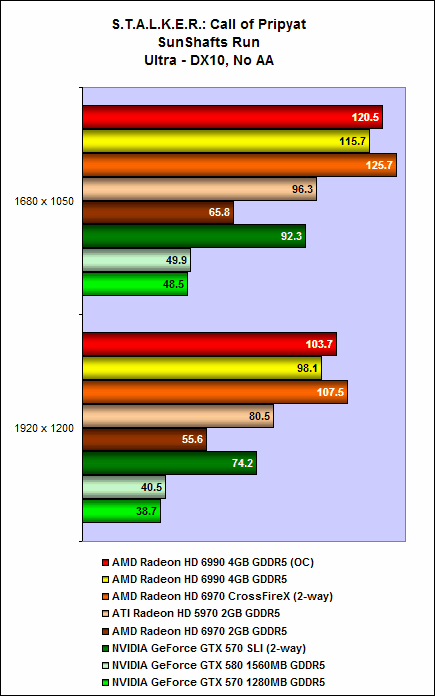 | 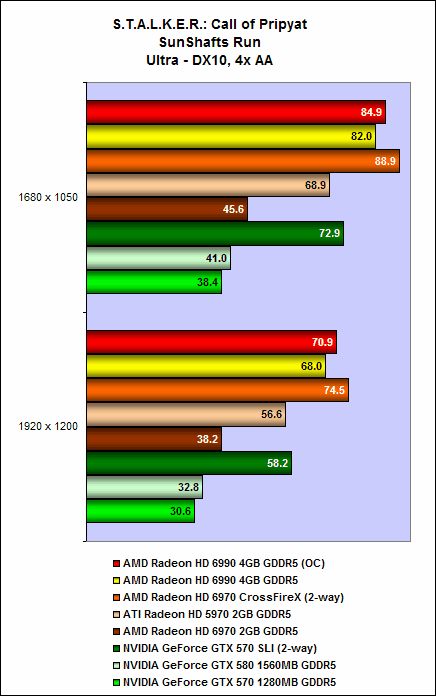 |
Temperature
Bearing in mind that a single Radeon HD 6970 runs at around 77 degrees Celsius, we were pretty impressed that the twin GPUs of the Radeon HD 6990 was running at a slightly cooler 75 degrees Celsius. With the Radeon HD 6990 switch to OC mode, the card recorded higher operating temperatures of 79 degrees Celsius. All in all, the new cooler design has done reasonably well to keep temperatures of the Radeon HD 6990 in check.

Power Consumption
With two GPUs onboard, the Radeon HD 6990 is a power hungry card, recording above 400W in our power consumption tests. Set the card into OC mode, and it consumes even more power. That said, we found that power draw was similar to two Radeon HD 6970 in CrossFireX configuration, and considerably lower than two GeForce GTX 570 in SLI, so at least there’s nothing unusual. However, what’s interesting is it’s power draw is so much higher compared to AMD’s previous flagship, the Radeon HD 5970.
Overall, while nothing unusual, we're disappointed that AMD hadn't made the Radeon HD 6990 more power efficient, an important trump card that's needed to convince enthusiasts of a dual-GPU single card proposition.

Overclocking
Overclocking on the Radeon HD 6990 can only achieved with the BIOS switch set to OC mode, and we must remind you that doing so voids your warranty. Using the in-built Catalyst Overdrive function, since MSI Afterburner was giving us some problems, we managed 950MHz at the core and 5200MHz DDR at the memory. This gave us 19589 3DMarks, an improvement of 533 3DMarks or 2%.

The Graphics King and its Caveats
Make no bones about it, the new US$700 AMD Radeon HD 6990 is the new fastest single graphics card in the world. It offers good performance increase over the previous dual-GPU Radeon HD 5970 and it was substantially quicker than NVIDIA’s fearsome GeForce GTX 580. If you want the ultimate single graphics card and do not care what it takes to run it and what shortcomings it might have, you might as well stop reading and go out and get the Radeon HD 6990 now. But if you are cautious about this investment, read on.
While the Radeon HD 6990 is super quick, it does have a couple of shortcomings that warrant consideration. First and foremost, it’s still not as quick as two Radeon HD 6970 in CrossFire configuration. Undoubtedly, much of that has to do with its slightly blunted clock speeds, because even in OC mode, its’ memory clock speeds are still 500MHz DDR slower.
Obviously, having two GPUs on a single PCB is going to pose some problems, especially with the issue of exhausting heat, but given that this is not AMD’s first dual-GPU card, we had expected them the Radeon HD 6990 to do better. Yet another aspect that we didn't see improvement is in power efficiency, which the Radeon HD 6970 didn't have any advantage over a CrossFire configuration of the Radeon HD 6970 cards.
One of the biggest misgivings of the Radeon HD 5970 was that it didn’t run at the clock speeds a single Radeon HD 5870 did, and we had expected AMD to do good with the Radeon HD 6990, but clearly they didn’t. Furthermore, speaking of OC mode, we are also miffed that AMD will not honor warranty if the you activate it. According to various sources (Kitguru, Anandtech), flipping the switch alone is enough for warranty voided. We think this kind of defeats the purpose of the OC mode, because how many people would like to take a chance on a US$700 card? Would you?

In many ways, the Radeon HD 6990 is like an exotic supercar. It's very fast, but also very expensive, impractical, and has many quirks.
Back to the issue on heat, the card also gets really loud and noisy when heavily taxed. It’s bad enough that we think you’d need headphones to really enjoy gaming when this card is in full song.
To add, AMD has also recommended that should you decide to CrossFire this beast, you would need, or rather, you are highly recommended to leave an expansion slot free between the two cards. The reason behind is that with one card beside another, the card behind will be starved of air since the intake fan is now in a central location. This makes the Radeon HD 6990 cumbersome to CrossFire, because not many motherboards, even high-end ones, have such a configuration that will make it possible to leave a gap between two cards in a multi-GPU configuration. While enthusiasts usually leave a gap when using dual graphics cards, this is probably the first time we're seeing it as a mandatory requirement. If so, this automatically translates that you should leave as much gap between two cards as possible - a real luxury that very few can fulfill.
Then again, this is not a normal card. As our benchmarks show, you’d need a very powerful system and super high resolution screens to be able to take full advantage of it. And with that said, it’s fair to say that users of this card will probably also have very high-end EATX or XL-ATX motherboard, that will make CrossFiring this card easy.
Finally, it’s also useful to note that for US$700, you could easily get two reference Radeon HD 6970 cards, which in CrossFireX will perform better than a single Radeon HD 6990. In light of this, the Radeon HD 6990 can’t be said to be very good value for money can it?
In the end, the Radeon HD 6990 is a very, very specialized product for unique consumers who demand only the very best. If you need a quad GPU setup for the best of the best performance with a pair of Radeon HD 6990 instead of cracking your brains for a casing and motherboard support for four Radeon HD 6970 cards, this is probably one of the few advantages this new kingpin has to offer. Meanwhile, stay tuned as the green camp has something up their sleeves to rival AMD in the following week.
|  |
Our articles may contain affiliate links. If you buy through these links, we may earn a small commission.
